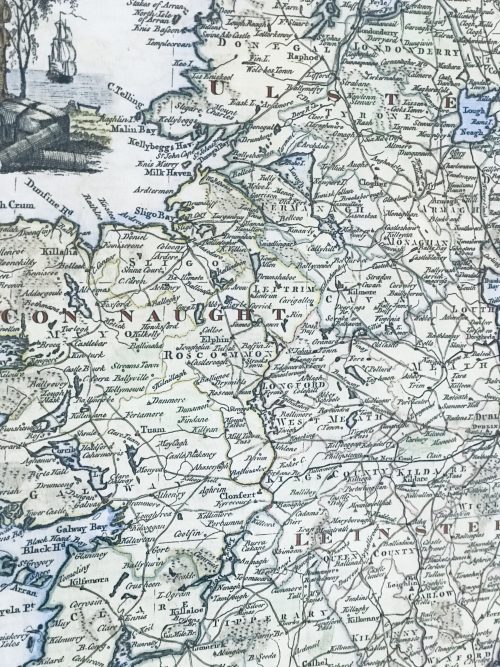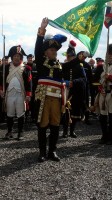-

 34cm x 27cm Dublin A beautiful souvenir Powers Whiskey print advertising the company's participation at the 1893 World Fair held in Chicago to celebrate the 400th anniversary of Christopher Columbus's arrival in the New World in 1492.The fair was an influential social and cultural event and had a profound effect on architecture,sanitation,the Arts,Chicago's self image and American Industrial optimism .Powers Whiskey itself was established in 1792 before moving to Johns Lane in 1822 and then expanding its ranks and production levels rapidly to become one of the most impressive architectural sights in Victorian Dublin-an overhead view of which is depicted in this beautiful print. In 1791 James Power, an innkeeper from Dublin, established a small distillery at his public house at 109 Thomas St., Dublin. The distillery, which had an output of about 6,000 gallons in its first year of operation, initially traded as James Power and Son, but by 1822 had become John Power & Son,and had moved to a new premises at John’s Lane, a side street off Thomas Street. At the time the distillery had three pot stills, though only one, a 500-gallon still is thought to have been in use. Following reform of the distilling laws in 1823, the distillery expanded rapidly. In 1827, production was reported at 160,270 gallons,and by 1833 had grown to 300,000 gallons per annum. As the distillery grew, so too did the stature of the family. In 1841, John Power, grandson of the founder was awarded a baronet, a hereditary title. In 1855, his son Sir James Power, laid the foundation stone for the O’Connell Monument, and in 1859 became High Sheriff of Dublin. In 1871, the distillery was expanded and rebuilt in the Victorian style, becoming one of the most impressive sights in Dublin.After expansion, output at the distillery rose to 700,000 gallons per annum, and by the 1880s, had reached about 900,000 gallons per annum, at which point the distillery covered over six acres of central Dublin, and had a staff of about 300 people.During this period, when the Dublin whiskey distilleries were amongst the largest in the world, the family run firms of John Powers, along with John Jameson, William Jameson, and George Roe, (collectively known as the “Big Four”) came to dominate the Irish distilling landscape, introducing several innovations. In 1886, John Power & Son began bottling their own whiskey, rather than following the practice customary at the time, of selling whiskey directly to merchants and bonders who would bottle it themselves. They were the first Dublin distillery to do so, and one of the first in the world.A gold label adorned each bottle and it was from these that the whiskey got the name Powers Gold Label. When Alfred Barnard, the British historian visited John’s Lane in the late 1880s, he noted the elegance and cleanliness of the buildings, and the modernity of the distillery, describing it as “about as complete a work as it is possible to find anywhere”. At the time of his visit, the distillery was home to five pot stills, two of which with capacities of 25,000 gallons, were amongst the largest ever built.In addition, Barnard was high in his praise for Powers whiskey, noting:”The old make, which we drank with our luncheon was delicious and finer than anything we had hitherto tasted.It was as perfect in flavour, and as pronounced in the ancient aroma of Irish Whiskey so dear to to the hearts of connoisseurs,as one could possibly desire and we found a small flask of it very useful afterwards on our travels.” The last member of the family to sit on the board was Sir Thomas Talbot Power,who died in 1930,and with him the Power’s Baronetcy. However, ownership remained in the family until 1966, and several descendants of his sisters remained at work with the company until recent times. In 1961, a Coffey still was installed in John’s Lane Distillery, allowing the production of vodka and gin, in addition to the testing of grain whiskey for use in blended whiskey. This was a notable departure for the firm, as for many years the big Dublin distilling dynasties had shunned the use of Coffey stills, questioning if their output, grain whiskey could even be termed whiskey. However, with many of the Irish distilleries having closed in the early 20th century in part due to their failure to embrace a change in consumer preference towards blended whiskey, Powers were instrumental in convincing the remaining Irish distilleries to reconsider their stance on blended whiskey. In 1966, with the Irish whiskey industry still struggling following Prohibition in the United States, the Anglo-Irish Trade War and the rise of competition from Scotch whiskey, John Powers & Son joined forces with the only other remaining distillers in the Irish Republic, the Cork Distilleries Company and their Dublin rivals John Jameson & Son, to form Irish Distillers. Soon after, in a bold move, Irish Distillers decided to close all of their existing distilleries, and to consolidate production at a new purpose-built facility in Midleton (the New Midleton Distillery) alongside their existing Old Midleton Distillery. The new distillery opened in 1975, and a year later, production ceased at John’s Lane Distillery and began anew in Cork, with Powers Gold Label and many other Irish whiskeys reformulated from single pot stills whiskeys to blends. In 1989, Irish Distillers itself became a subsidiary of Pernod-Ricard following a friendly takeover.Since the closure of the John’s Lane distillery, many of the distillery buildings were demolished. However, some of the buildings have been incorporated into the National College of Art and Design, and are now protected structures. In addition, three of the distillery’s pot stills were saved and now located in the college’s Red Square.
34cm x 27cm Dublin A beautiful souvenir Powers Whiskey print advertising the company's participation at the 1893 World Fair held in Chicago to celebrate the 400th anniversary of Christopher Columbus's arrival in the New World in 1492.The fair was an influential social and cultural event and had a profound effect on architecture,sanitation,the Arts,Chicago's self image and American Industrial optimism .Powers Whiskey itself was established in 1792 before moving to Johns Lane in 1822 and then expanding its ranks and production levels rapidly to become one of the most impressive architectural sights in Victorian Dublin-an overhead view of which is depicted in this beautiful print. In 1791 James Power, an innkeeper from Dublin, established a small distillery at his public house at 109 Thomas St., Dublin. The distillery, which had an output of about 6,000 gallons in its first year of operation, initially traded as James Power and Son, but by 1822 had become John Power & Son,and had moved to a new premises at John’s Lane, a side street off Thomas Street. At the time the distillery had three pot stills, though only one, a 500-gallon still is thought to have been in use. Following reform of the distilling laws in 1823, the distillery expanded rapidly. In 1827, production was reported at 160,270 gallons,and by 1833 had grown to 300,000 gallons per annum. As the distillery grew, so too did the stature of the family. In 1841, John Power, grandson of the founder was awarded a baronet, a hereditary title. In 1855, his son Sir James Power, laid the foundation stone for the O’Connell Monument, and in 1859 became High Sheriff of Dublin. In 1871, the distillery was expanded and rebuilt in the Victorian style, becoming one of the most impressive sights in Dublin.After expansion, output at the distillery rose to 700,000 gallons per annum, and by the 1880s, had reached about 900,000 gallons per annum, at which point the distillery covered over six acres of central Dublin, and had a staff of about 300 people.During this period, when the Dublin whiskey distilleries were amongst the largest in the world, the family run firms of John Powers, along with John Jameson, William Jameson, and George Roe, (collectively known as the “Big Four”) came to dominate the Irish distilling landscape, introducing several innovations. In 1886, John Power & Son began bottling their own whiskey, rather than following the practice customary at the time, of selling whiskey directly to merchants and bonders who would bottle it themselves. They were the first Dublin distillery to do so, and one of the first in the world.A gold label adorned each bottle and it was from these that the whiskey got the name Powers Gold Label. When Alfred Barnard, the British historian visited John’s Lane in the late 1880s, he noted the elegance and cleanliness of the buildings, and the modernity of the distillery, describing it as “about as complete a work as it is possible to find anywhere”. At the time of his visit, the distillery was home to five pot stills, two of which with capacities of 25,000 gallons, were amongst the largest ever built.In addition, Barnard was high in his praise for Powers whiskey, noting:”The old make, which we drank with our luncheon was delicious and finer than anything we had hitherto tasted.It was as perfect in flavour, and as pronounced in the ancient aroma of Irish Whiskey so dear to to the hearts of connoisseurs,as one could possibly desire and we found a small flask of it very useful afterwards on our travels.” The last member of the family to sit on the board was Sir Thomas Talbot Power,who died in 1930,and with him the Power’s Baronetcy. However, ownership remained in the family until 1966, and several descendants of his sisters remained at work with the company until recent times. In 1961, a Coffey still was installed in John’s Lane Distillery, allowing the production of vodka and gin, in addition to the testing of grain whiskey for use in blended whiskey. This was a notable departure for the firm, as for many years the big Dublin distilling dynasties had shunned the use of Coffey stills, questioning if their output, grain whiskey could even be termed whiskey. However, with many of the Irish distilleries having closed in the early 20th century in part due to their failure to embrace a change in consumer preference towards blended whiskey, Powers were instrumental in convincing the remaining Irish distilleries to reconsider their stance on blended whiskey. In 1966, with the Irish whiskey industry still struggling following Prohibition in the United States, the Anglo-Irish Trade War and the rise of competition from Scotch whiskey, John Powers & Son joined forces with the only other remaining distillers in the Irish Republic, the Cork Distilleries Company and their Dublin rivals John Jameson & Son, to form Irish Distillers. Soon after, in a bold move, Irish Distillers decided to close all of their existing distilleries, and to consolidate production at a new purpose-built facility in Midleton (the New Midleton Distillery) alongside their existing Old Midleton Distillery. The new distillery opened in 1975, and a year later, production ceased at John’s Lane Distillery and began anew in Cork, with Powers Gold Label and many other Irish whiskeys reformulated from single pot stills whiskeys to blends. In 1989, Irish Distillers itself became a subsidiary of Pernod-Ricard following a friendly takeover.Since the closure of the John’s Lane distillery, many of the distillery buildings were demolished. However, some of the buildings have been incorporated into the National College of Art and Design, and are now protected structures. In addition, three of the distillery’s pot stills were saved and now located in the college’s Red Square. The Still House at John’s Lane Distillery, as it looked when Alfred Barnard visited in the 1800s.
The Still House at John’s Lane Distillery, as it looked when Alfred Barnard visited in the 1800s.
-
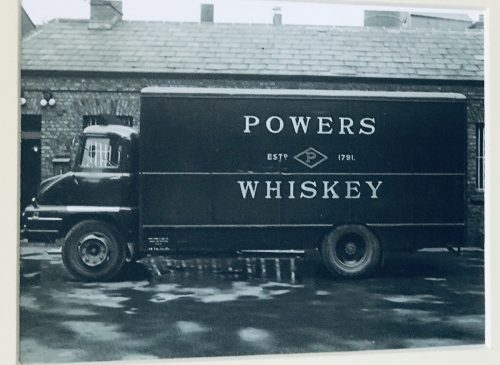
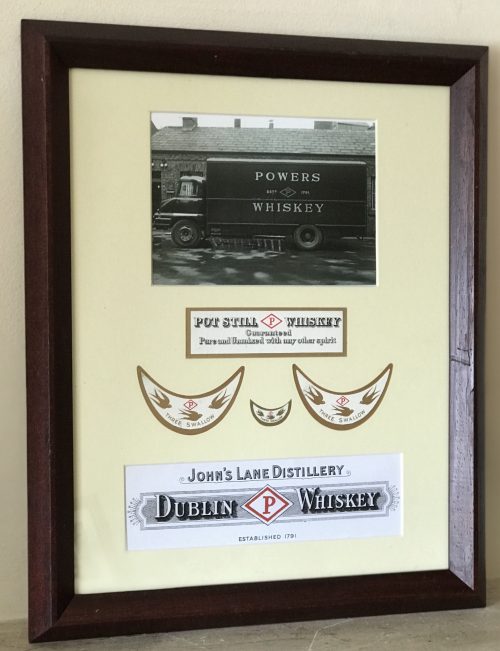 39cm x 30cm Dublin John Power & Son Dublin Irish Whiskey display of Power's ephemera and one of its delivery lorries at its Johns Lane distillery. In 1791 James Power, an innkeeper from Dublin, established a small distillery at his public house at 109 Thomas St., Dublin. The distillery, which had an output of about 6,000 gallons in its first year of operation, initially traded as James Power and Son, but by 1822 had become John Power & Son,and had moved to a new premises at John’s Lane, a side street off Thomas Street. At the time the distillery had three pot stills, though only one, a 500-gallon still is thought to have been in use. Following reform of the distilling laws in 1823, the distillery expanded rapidly. In 1827, production was reported at 160,270 gallons,and by 1833 had grown to 300,000 gallons per annum. As the distillery grew, so too did the stature of the family. In 1841, John Power, grandson of the founder was awarded a baronet, a hereditary title. In 1855, his son Sir James Power, laid the foundation stone for the O’Connell Monument, and in 1859 became High Sheriff of Dublin. In 1871, the distillery was expanded and rebuilt in the Victorian style, becoming one of the most impressive sights in Dublin.After expansion, output at the distillery rose to 700,000 gallons per annum, and by the 1880s, had reached about 900,000 gallons per annum, at which point the distillery covered over six acres of central Dublin, and had a staff of about 300 people.During this period, when the Dublin whiskey distilleries were amongst the largest in the world, the family run firms of John Powers, along with John Jameson, William Jameson, and George Roe, (collectively known as the “Big Four”) came to dominate the Irish distilling landscape, introducing several innovations. In 1886, John Power & Son began bottling their own whiskey, rather than following the practice customary at the time, of selling whiskey directly to merchants and bonders who would bottle it themselves. They were the first Dublin distillery to do so, and one of the first in the world.A gold label adorned each bottle and it was from these that the whiskey got the name Powers Gold Label. When Alfred Barnard, the British historian visited John’s Lane in the late 1880s, he noted the elegance and cleanliness of the buildings, and the modernity of the distillery, describing it as “about as complete a work as it is possible to find anywhere”. At the time of his visit, the distillery was home to five pot stills, two of which with capacities of 25,000 gallons, were amongst the largest ever built.In addition, Barnard was high in his praise for Powers whiskey, noting:”The old make, which we drank with our luncheon was delicious and finer than anything we had hitherto tasted.It was as perfect in flavour, and as pronounced in the ancient aroma of Irish Whiskey so dear to to the hearts of connoisseurs,as one could possibly desire and we found a small flask of it very useful afterwards on our travels.” The last member of the family to sit on the board was Sir Thomas Talbot Power,who died in 1930,and with him the Power’s Baronetcy. However, ownership remained in the family until 1966, and several descendants of his sisters remained at work with the company until recent times. In 1961, a Coffey still was installed in John’s Lane Distillery, allowing the production of vodka and gin, in addition to the testing of grain whiskey for use in blended whiskey. This was a notable departure for the firm, as for many years the big Dublin distilling dynasties had shunned the use of Coffey stills, questioning if their output, grain whiskey could even be termed whiskey. However, with many of the Irish distilleries having closed in the early 20th century in part due to their failure to embrace a change in consumer preference towards blended whiskey, Powers were instrumental in convincing the remaining Irish distilleries to reconsider their stance on blended whiskey. In 1966, with the Irish whiskey industry still struggling following Prohibition in the United States, the Anglo-Irish Trade War and the rise of competition from Scotch whiskey, John Powers & Son joined forces with the only other remaining distillers in the Irish Republic, the Cork Distilleries Company and their Dublin rivals John Jameson & Son, to form Irish Distillers. Soon after, in a bold move, Irish Distillers decided to close all of their existing distilleries, and to consolidate production at a new purpose-built facility in Midleton (the New Midleton Distillery) alongside their existing Old Midleton Distillery. The new distillery opened in 1975, and a year later, production ceased at John’s Lane Distillery and began anew in Cork, with Powers Gold Label and many other Irish whiskeys reformulated from single pot stills whiskeys to blends. In 1989, Irish Distillers itself became a subsidiary of Pernod-Ricard following a friendly takeover.Since the closure of the John’s Lane distillery, many of the distillery buildings were demolished. However, some of the buildings have been incorporated into the National College of Art and Design, and are now protected structures. In addition, three of the distillery’s pot stills were saved and now located in the college’s Red Square.
39cm x 30cm Dublin John Power & Son Dublin Irish Whiskey display of Power's ephemera and one of its delivery lorries at its Johns Lane distillery. In 1791 James Power, an innkeeper from Dublin, established a small distillery at his public house at 109 Thomas St., Dublin. The distillery, which had an output of about 6,000 gallons in its first year of operation, initially traded as James Power and Son, but by 1822 had become John Power & Son,and had moved to a new premises at John’s Lane, a side street off Thomas Street. At the time the distillery had three pot stills, though only one, a 500-gallon still is thought to have been in use. Following reform of the distilling laws in 1823, the distillery expanded rapidly. In 1827, production was reported at 160,270 gallons,and by 1833 had grown to 300,000 gallons per annum. As the distillery grew, so too did the stature of the family. In 1841, John Power, grandson of the founder was awarded a baronet, a hereditary title. In 1855, his son Sir James Power, laid the foundation stone for the O’Connell Monument, and in 1859 became High Sheriff of Dublin. In 1871, the distillery was expanded and rebuilt in the Victorian style, becoming one of the most impressive sights in Dublin.After expansion, output at the distillery rose to 700,000 gallons per annum, and by the 1880s, had reached about 900,000 gallons per annum, at which point the distillery covered over six acres of central Dublin, and had a staff of about 300 people.During this period, when the Dublin whiskey distilleries were amongst the largest in the world, the family run firms of John Powers, along with John Jameson, William Jameson, and George Roe, (collectively known as the “Big Four”) came to dominate the Irish distilling landscape, introducing several innovations. In 1886, John Power & Son began bottling their own whiskey, rather than following the practice customary at the time, of selling whiskey directly to merchants and bonders who would bottle it themselves. They were the first Dublin distillery to do so, and one of the first in the world.A gold label adorned each bottle and it was from these that the whiskey got the name Powers Gold Label. When Alfred Barnard, the British historian visited John’s Lane in the late 1880s, he noted the elegance and cleanliness of the buildings, and the modernity of the distillery, describing it as “about as complete a work as it is possible to find anywhere”. At the time of his visit, the distillery was home to five pot stills, two of which with capacities of 25,000 gallons, were amongst the largest ever built.In addition, Barnard was high in his praise for Powers whiskey, noting:”The old make, which we drank with our luncheon was delicious and finer than anything we had hitherto tasted.It was as perfect in flavour, and as pronounced in the ancient aroma of Irish Whiskey so dear to to the hearts of connoisseurs,as one could possibly desire and we found a small flask of it very useful afterwards on our travels.” The last member of the family to sit on the board was Sir Thomas Talbot Power,who died in 1930,and with him the Power’s Baronetcy. However, ownership remained in the family until 1966, and several descendants of his sisters remained at work with the company until recent times. In 1961, a Coffey still was installed in John’s Lane Distillery, allowing the production of vodka and gin, in addition to the testing of grain whiskey for use in blended whiskey. This was a notable departure for the firm, as for many years the big Dublin distilling dynasties had shunned the use of Coffey stills, questioning if their output, grain whiskey could even be termed whiskey. However, with many of the Irish distilleries having closed in the early 20th century in part due to their failure to embrace a change in consumer preference towards blended whiskey, Powers were instrumental in convincing the remaining Irish distilleries to reconsider their stance on blended whiskey. In 1966, with the Irish whiskey industry still struggling following Prohibition in the United States, the Anglo-Irish Trade War and the rise of competition from Scotch whiskey, John Powers & Son joined forces with the only other remaining distillers in the Irish Republic, the Cork Distilleries Company and their Dublin rivals John Jameson & Son, to form Irish Distillers. Soon after, in a bold move, Irish Distillers decided to close all of their existing distilleries, and to consolidate production at a new purpose-built facility in Midleton (the New Midleton Distillery) alongside their existing Old Midleton Distillery. The new distillery opened in 1975, and a year later, production ceased at John’s Lane Distillery and began anew in Cork, with Powers Gold Label and many other Irish whiskeys reformulated from single pot stills whiskeys to blends. In 1989, Irish Distillers itself became a subsidiary of Pernod-Ricard following a friendly takeover.Since the closure of the John’s Lane distillery, many of the distillery buildings were demolished. However, some of the buildings have been incorporated into the National College of Art and Design, and are now protected structures. In addition, three of the distillery’s pot stills were saved and now located in the college’s Red Square. The Still House at John’s Lane Distillery, as it looked when Alfred Barnard visited in the 1800s.
The Still House at John’s Lane Distillery, as it looked when Alfred Barnard visited in the 1800s.
-
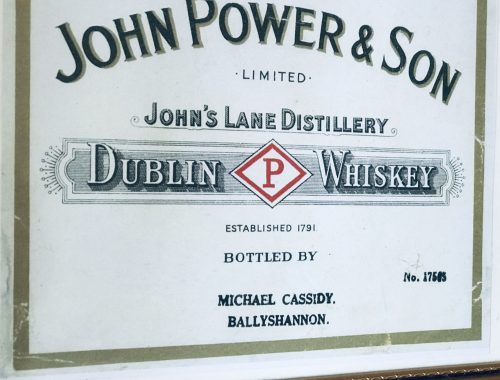
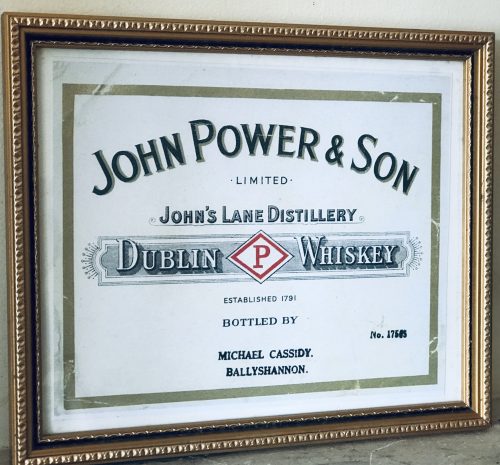 25cm x 30cm Ballyshannon Co Donegal John Power & Son Dublin Irish Whiskey Label as bottled by James Cassidy Ballyshannon Co Donegal. In 1791 James Power, an innkeeper from Dublin, established a small distillery at his public house at 109 Thomas St., Dublin. The distillery, which had an output of about 6,000 gallons in its first year of operation, initially traded as James Power and Son, but by 1822 had become John Power & Son,and had moved to a new premises at John’s Lane, a side street off Thomas Street. At the time the distillery had three pot stills, though only one, a 500-gallon still is thought to have been in use. Following reform of the distilling laws in 1823, the distillery expanded rapidly. In 1827, production was reported at 160,270 gallons,and by 1833 had grown to 300,000 gallons per annum. As the distillery grew, so too did the stature of the family. In 1841, John Power, grandson of the founder was awarded a baronet, a hereditary title. In 1855, his son Sir James Power, laid the foundation stone for the O’Connell Monument, and in 1859 became High Sheriff of Dublin. In 1871, the distillery was expanded and rebuilt in the Victorian style, becoming one of the most impressive sights in Dublin.After expansion, output at the distillery rose to 700,000 gallons per annum, and by the 1880s, had reached about 900,000 gallons per annum, at which point the distillery covered over six acres of central Dublin, and had a staff of about 300 people.During this period, when the Dublin whiskey distilleries were amongst the largest in the world, the family run firms of John Powers, along with John Jameson, William Jameson, and George Roe, (collectively known as the “Big Four”) came to dominate the Irish distilling landscape, introducing several innovations. In 1886, John Power & Son began bottling their own whiskey, rather than following the practice customary at the time, of selling whiskey directly to merchants and bonders who would bottle it themselves. They were the first Dublin distillery to do so, and one of the first in the world.A gold label adorned each bottle and it was from these that the whiskey got the name Powers Gold Label. When Alfred Barnard, the British historian visited John’s Lane in the late 1880s, he noted the elegance and cleanliness of the buildings, and the modernity of the distillery, describing it as “about as complete a work as it is possible to find anywhere”. At the time of his visit, the distillery was home to five pot stills, two of which with capacities of 25,000 gallons, were amongst the largest ever built.In addition, Barnard was high in his praise for Powers whiskey, noting:”The old make, which we drank with our luncheon was delicious and finer than anything we had hitherto tasted.It was as perfect in flavour, and as pronounced in the ancient aroma of Irish Whiskey so dear to to the hearts of connoisseurs,as one could possibly desire and we found a small flask of it very useful afterwards on our travels.” The last member of the family to sit on the board was Sir Thomas Talbot Power,who died in 1930,and with him the Power’s Baronetcy. However, ownership remained in the family until 1966, and several descendants of his sisters remained at work with the company until recent times. In 1961, a Coffey still was installed in John’s Lane Distillery, allowing the production of vodka and gin, in addition to the testing of grain whiskey for use in blended whiskey. This was a notable departure for the firm, as for many years the big Dublin distilling dynasties had shunned the use of Coffey stills, questioning if their output, grain whiskey could even be termed whiskey. However, with many of the Irish distilleries having closed in the early 20th century in part due to their failure to embrace a change in consumer preference towards blended whiskey, Powers were instrumental in convincing the remaining Irish distilleries to reconsider their stance on blended whiskey. In 1966, with the Irish whiskey industry still struggling following Prohibition in the United States, the Anglo-Irish Trade War and the rise of competition from Scotch whiskey, John Powers & Son joined forces with the only other remaining distillers in the Irish Republic, the Cork Distilleries Company and their Dublin rivals John Jameson & Son, to form Irish Distillers. Soon after, in a bold move, Irish Distillers decided to close all of their existing distilleries, and to consolidate production at a new purpose-built facility in Midleton (the New Midleton Distillery) alongside their existing Old Midleton Distillery. The new distillery opened in 1975, and a year later, production ceased at John’s Lane Distillery and began anew in Cork, with Powers Gold Label and many other Irish whiskeys reformulated from single pot stills whiskeys to blends. In 1989, Irish Distillers itself became a subsidiary of Pernod-Ricard following a friendly takeover.Since the closure of the John’s Lane distillery, many of the distillery buildings were demolished. However, some of the buildings have been incorporated into the National College of Art and Design, and are now protected structures. In addition, three of the distillery’s pot stills were saved and now located in the college’s Red Square.
25cm x 30cm Ballyshannon Co Donegal John Power & Son Dublin Irish Whiskey Label as bottled by James Cassidy Ballyshannon Co Donegal. In 1791 James Power, an innkeeper from Dublin, established a small distillery at his public house at 109 Thomas St., Dublin. The distillery, which had an output of about 6,000 gallons in its first year of operation, initially traded as James Power and Son, but by 1822 had become John Power & Son,and had moved to a new premises at John’s Lane, a side street off Thomas Street. At the time the distillery had three pot stills, though only one, a 500-gallon still is thought to have been in use. Following reform of the distilling laws in 1823, the distillery expanded rapidly. In 1827, production was reported at 160,270 gallons,and by 1833 had grown to 300,000 gallons per annum. As the distillery grew, so too did the stature of the family. In 1841, John Power, grandson of the founder was awarded a baronet, a hereditary title. In 1855, his son Sir James Power, laid the foundation stone for the O’Connell Monument, and in 1859 became High Sheriff of Dublin. In 1871, the distillery was expanded and rebuilt in the Victorian style, becoming one of the most impressive sights in Dublin.After expansion, output at the distillery rose to 700,000 gallons per annum, and by the 1880s, had reached about 900,000 gallons per annum, at which point the distillery covered over six acres of central Dublin, and had a staff of about 300 people.During this period, when the Dublin whiskey distilleries were amongst the largest in the world, the family run firms of John Powers, along with John Jameson, William Jameson, and George Roe, (collectively known as the “Big Four”) came to dominate the Irish distilling landscape, introducing several innovations. In 1886, John Power & Son began bottling their own whiskey, rather than following the practice customary at the time, of selling whiskey directly to merchants and bonders who would bottle it themselves. They were the first Dublin distillery to do so, and one of the first in the world.A gold label adorned each bottle and it was from these that the whiskey got the name Powers Gold Label. When Alfred Barnard, the British historian visited John’s Lane in the late 1880s, he noted the elegance and cleanliness of the buildings, and the modernity of the distillery, describing it as “about as complete a work as it is possible to find anywhere”. At the time of his visit, the distillery was home to five pot stills, two of which with capacities of 25,000 gallons, were amongst the largest ever built.In addition, Barnard was high in his praise for Powers whiskey, noting:”The old make, which we drank with our luncheon was delicious and finer than anything we had hitherto tasted.It was as perfect in flavour, and as pronounced in the ancient aroma of Irish Whiskey so dear to to the hearts of connoisseurs,as one could possibly desire and we found a small flask of it very useful afterwards on our travels.” The last member of the family to sit on the board was Sir Thomas Talbot Power,who died in 1930,and with him the Power’s Baronetcy. However, ownership remained in the family until 1966, and several descendants of his sisters remained at work with the company until recent times. In 1961, a Coffey still was installed in John’s Lane Distillery, allowing the production of vodka and gin, in addition to the testing of grain whiskey for use in blended whiskey. This was a notable departure for the firm, as for many years the big Dublin distilling dynasties had shunned the use of Coffey stills, questioning if their output, grain whiskey could even be termed whiskey. However, with many of the Irish distilleries having closed in the early 20th century in part due to their failure to embrace a change in consumer preference towards blended whiskey, Powers were instrumental in convincing the remaining Irish distilleries to reconsider their stance on blended whiskey. In 1966, with the Irish whiskey industry still struggling following Prohibition in the United States, the Anglo-Irish Trade War and the rise of competition from Scotch whiskey, John Powers & Son joined forces with the only other remaining distillers in the Irish Republic, the Cork Distilleries Company and their Dublin rivals John Jameson & Son, to form Irish Distillers. Soon after, in a bold move, Irish Distillers decided to close all of their existing distilleries, and to consolidate production at a new purpose-built facility in Midleton (the New Midleton Distillery) alongside their existing Old Midleton Distillery. The new distillery opened in 1975, and a year later, production ceased at John’s Lane Distillery and began anew in Cork, with Powers Gold Label and many other Irish whiskeys reformulated from single pot stills whiskeys to blends. In 1989, Irish Distillers itself became a subsidiary of Pernod-Ricard following a friendly takeover.Since the closure of the John’s Lane distillery, many of the distillery buildings were demolished. However, some of the buildings have been incorporated into the National College of Art and Design, and are now protected structures. In addition, three of the distillery’s pot stills were saved and now located in the college’s Red Square. The Still House at John’s Lane Distillery, as it looked when Alfred Barnard visited in the 1800s.
The Still House at John’s Lane Distillery, as it looked when Alfred Barnard visited in the 1800s.
-
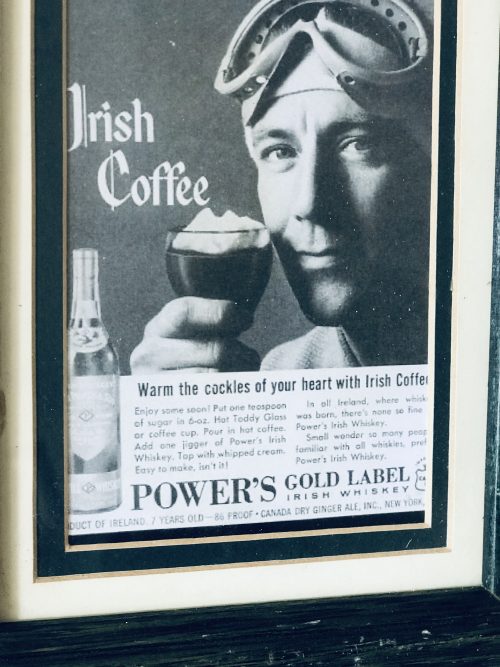
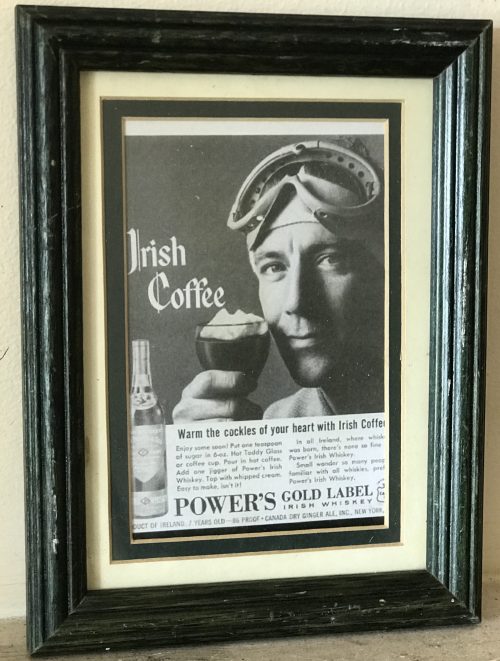 20cm x 15cm Dublin John Power & Son Dublin Irish Whiskey Label as bottled by James Cassidy Ballyshannon Co Donegal. In 1791 James Power, an innkeeper from Dublin, established a small distillery at his public house at 109 Thomas St., Dublin. The distillery, which had an output of about 6,000 gallons in its first year of operation, initially traded as James Power and Son, but by 1822 had become John Power & Son,and had moved to a new premises at John’s Lane, a side street off Thomas Street. At the time the distillery had three pot stills, though only one, a 500-gallon still is thought to have been in use. Following reform of the distilling laws in 1823, the distillery expanded rapidly. In 1827, production was reported at 160,270 gallons,and by 1833 had grown to 300,000 gallons per annum. As the distillery grew, so too did the stature of the family. In 1841, John Power, grandson of the founder was awarded a baronet, a hereditary title. In 1855, his son Sir James Power, laid the foundation stone for the O’Connell Monument, and in 1859 became High Sheriff of Dublin. In 1871, the distillery was expanded and rebuilt in the Victorian style, becoming one of the most impressive sights in Dublin.After expansion, output at the distillery rose to 700,000 gallons per annum, and by the 1880s, had reached about 900,000 gallons per annum, at which point the distillery covered over six acres of central Dublin, and had a staff of about 300 people.During this period, when the Dublin whiskey distilleries were amongst the largest in the world, the family run firms of John Powers, along with John Jameson, William Jameson, and George Roe, (collectively known as the “Big Four”) came to dominate the Irish distilling landscape, introducing several innovations. In 1886, John Power & Son began bottling their own whiskey, rather than following the practice customary at the time, of selling whiskey directly to merchants and bonders who would bottle it themselves. They were the first Dublin distillery to do so, and one of the first in the world.A gold label adorned each bottle and it was from these that the whiskey got the name Powers Gold Label. When Alfred Barnard, the British historian visited John’s Lane in the late 1880s, he noted the elegance and cleanliness of the buildings, and the modernity of the distillery, describing it as “about as complete a work as it is possible to find anywhere”. At the time of his visit, the distillery was home to five pot stills, two of which with capacities of 25,000 gallons, were amongst the largest ever built.In addition, Barnard was high in his praise for Powers whiskey, noting:”The old make, which we drank with our luncheon was delicious and finer than anything we had hitherto tasted.It was as perfect in flavour, and as pronounced in the ancient aroma of Irish Whiskey so dear to to the hearts of connoisseurs,as one could possibly desire and we found a small flask of it very useful afterwards on our travels.” The last member of the family to sit on the board was Sir Thomas Talbot Power,who died in 1930,and with him the Power’s Baronetcy. However, ownership remained in the family until 1966, and several descendants of his sisters remained at work with the company until recent times. In 1961, a Coffey still was installed in John’s Lane Distillery, allowing the production of vodka and gin, in addition to the testing of grain whiskey for use in blended whiskey. This was a notable departure for the firm, as for many years the big Dublin distilling dynasties had shunned the use of Coffey stills, questioning if their output, grain whiskey could even be termed whiskey. However, with many of the Irish distilleries having closed in the early 20th century in part due to their failure to embrace a change in consumer preference towards blended whiskey, Powers were instrumental in convincing the remaining Irish distilleries to reconsider their stance on blended whiskey. In 1966, with the Irish whiskey industry still struggling following Prohibition in the United States, the Anglo-Irish Trade War and the rise of competition from Scotch whiskey, John Powers & Son joined forces with the only other remaining distillers in the Irish Republic, the Cork Distilleries Company and their Dublin rivals John Jameson & Son, to form Irish Distillers. Soon after, in a bold move, Irish Distillers decided to close all of their existing distilleries, and to consolidate production at a new purpose-built facility in Midleton (the New Midleton Distillery) alongside their existing Old Midleton Distillery. The new distillery opened in 1975, and a year later, production ceased at John’s Lane Distillery and began anew in Cork, with Powers Gold Label and many other Irish whiskeys reformulated from single pot stills whiskeys to blends. In 1989, Irish Distillers itself became a subsidiary of Pernod-Ricard following a friendly takeover.Since the closure of the John’s Lane distillery, many of the distillery buildings were demolished. However, some of the buildings have been incorporated into the National College of Art and Design, and are now protected structures. In addition, three of the distillery’s pot stills were saved and now located in the college’s Red Square.
20cm x 15cm Dublin John Power & Son Dublin Irish Whiskey Label as bottled by James Cassidy Ballyshannon Co Donegal. In 1791 James Power, an innkeeper from Dublin, established a small distillery at his public house at 109 Thomas St., Dublin. The distillery, which had an output of about 6,000 gallons in its first year of operation, initially traded as James Power and Son, but by 1822 had become John Power & Son,and had moved to a new premises at John’s Lane, a side street off Thomas Street. At the time the distillery had three pot stills, though only one, a 500-gallon still is thought to have been in use. Following reform of the distilling laws in 1823, the distillery expanded rapidly. In 1827, production was reported at 160,270 gallons,and by 1833 had grown to 300,000 gallons per annum. As the distillery grew, so too did the stature of the family. In 1841, John Power, grandson of the founder was awarded a baronet, a hereditary title. In 1855, his son Sir James Power, laid the foundation stone for the O’Connell Monument, and in 1859 became High Sheriff of Dublin. In 1871, the distillery was expanded and rebuilt in the Victorian style, becoming one of the most impressive sights in Dublin.After expansion, output at the distillery rose to 700,000 gallons per annum, and by the 1880s, had reached about 900,000 gallons per annum, at which point the distillery covered over six acres of central Dublin, and had a staff of about 300 people.During this period, when the Dublin whiskey distilleries were amongst the largest in the world, the family run firms of John Powers, along with John Jameson, William Jameson, and George Roe, (collectively known as the “Big Four”) came to dominate the Irish distilling landscape, introducing several innovations. In 1886, John Power & Son began bottling their own whiskey, rather than following the practice customary at the time, of selling whiskey directly to merchants and bonders who would bottle it themselves. They were the first Dublin distillery to do so, and one of the first in the world.A gold label adorned each bottle and it was from these that the whiskey got the name Powers Gold Label. When Alfred Barnard, the British historian visited John’s Lane in the late 1880s, he noted the elegance and cleanliness of the buildings, and the modernity of the distillery, describing it as “about as complete a work as it is possible to find anywhere”. At the time of his visit, the distillery was home to five pot stills, two of which with capacities of 25,000 gallons, were amongst the largest ever built.In addition, Barnard was high in his praise for Powers whiskey, noting:”The old make, which we drank with our luncheon was delicious and finer than anything we had hitherto tasted.It was as perfect in flavour, and as pronounced in the ancient aroma of Irish Whiskey so dear to to the hearts of connoisseurs,as one could possibly desire and we found a small flask of it very useful afterwards on our travels.” The last member of the family to sit on the board was Sir Thomas Talbot Power,who died in 1930,and with him the Power’s Baronetcy. However, ownership remained in the family until 1966, and several descendants of his sisters remained at work with the company until recent times. In 1961, a Coffey still was installed in John’s Lane Distillery, allowing the production of vodka and gin, in addition to the testing of grain whiskey for use in blended whiskey. This was a notable departure for the firm, as for many years the big Dublin distilling dynasties had shunned the use of Coffey stills, questioning if their output, grain whiskey could even be termed whiskey. However, with many of the Irish distilleries having closed in the early 20th century in part due to their failure to embrace a change in consumer preference towards blended whiskey, Powers were instrumental in convincing the remaining Irish distilleries to reconsider their stance on blended whiskey. In 1966, with the Irish whiskey industry still struggling following Prohibition in the United States, the Anglo-Irish Trade War and the rise of competition from Scotch whiskey, John Powers & Son joined forces with the only other remaining distillers in the Irish Republic, the Cork Distilleries Company and their Dublin rivals John Jameson & Son, to form Irish Distillers. Soon after, in a bold move, Irish Distillers decided to close all of their existing distilleries, and to consolidate production at a new purpose-built facility in Midleton (the New Midleton Distillery) alongside their existing Old Midleton Distillery. The new distillery opened in 1975, and a year later, production ceased at John’s Lane Distillery and began anew in Cork, with Powers Gold Label and many other Irish whiskeys reformulated from single pot stills whiskeys to blends. In 1989, Irish Distillers itself became a subsidiary of Pernod-Ricard following a friendly takeover.Since the closure of the John’s Lane distillery, many of the distillery buildings were demolished. However, some of the buildings have been incorporated into the National College of Art and Design, and are now protected structures. In addition, three of the distillery’s pot stills were saved and now located in the college’s Red Square. The Still House at John’s Lane Distillery, as it looked when Alfred Barnard visited in the 1800s.
The Still House at John’s Lane Distillery, as it looked when Alfred Barnard visited in the 1800s.
-
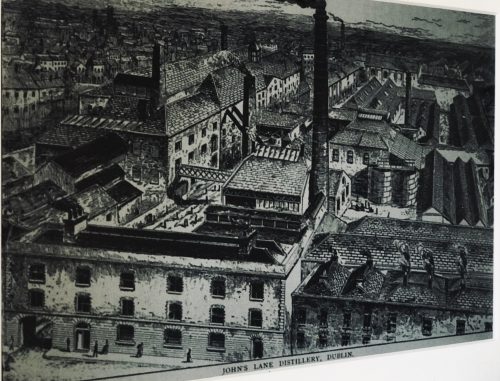
 29cm x 39cm Dublin Print from Alfred Barnards famous treatise of 1887 -The Whiskey Distilleries of the United Kingdom depicting the Johns Lane distillery of John Power & Son Dublin Irish Whiskey In 1791 James Power, an innkeeper from Dublin, established a small distillery at his public house at 109 Thomas St., Dublin. The distillery, which had an output of about 6,000 gallons in its first year of operation, initially traded as James Power and Son, but by 1822 had become John Power & Son,and had moved to a new premises at John’s Lane, a side street off Thomas Street. At the time the distillery had three pot stills, though only one, a 500-gallon still is thought to have been in use. Following reform of the distilling laws in 1823, the distillery expanded rapidly. In 1827, production was reported at 160,270 gallons,and by 1833 had grown to 300,000 gallons per annum. As the distillery grew, so too did the stature of the family. In 1841, John Power, grandson of the founder was awarded a baronet, a hereditary title. In 1855, his son Sir James Power, laid the foundation stone for the O’Connell Monument, and in 1859 became High Sheriff of Dublin. In 1871, the distillery was expanded and rebuilt in the Victorian style, becoming one of the most impressive sights in Dublin.After expansion, output at the distillery rose to 700,000 gallons per annum, and by the 1880s, had reached about 900,000 gallons per annum, at which point the distillery covered over six acres of central Dublin, and had a staff of about 300 people.During this period, when the Dublin whiskey distilleries were amongst the largest in the world, the family run firms of John Powers, along with John Jameson, William Jameson, and George Roe, (collectively known as the “Big Four”) came to dominate the Irish distilling landscape, introducing several innovations. In 1886, John Power & Son began bottling their own whiskey, rather than following the practice customary at the time, of selling whiskey directly to merchants and bonders who would bottle it themselves. They were the first Dublin distillery to do so, and one of the first in the world.A gold label adorned each bottle and it was from these that the whiskey got the name Powers Gold Label. When Alfred Barnard, the British historian visited John’s Lane in the late 1880s, he noted the elegance and cleanliness of the buildings, and the modernity of the distillery, describing it as “about as complete a work as it is possible to find anywhere”. At the time of his visit, the distillery was home to five pot stills, two of which with capacities of 25,000 gallons, were amongst the largest ever built.In addition, Barnard was high in his praise for Powers whiskey, noting:”The old make, which we drank with our luncheon was delicious and finer than anything we had hitherto tasted.It was as perfect in flavour, and as pronounced in the ancient aroma of Irish Whiskey so dear to to the hearts of connoisseurs,as one could possibly desire and we found a small flask of it very useful afterwards on our travels.” The last member of the family to sit on the board was Sir Thomas Talbot Power,who died in 1930,and with him the Power’s Baronetcy. However, ownership remained in the family until 1966, and several descendants of his sisters remained at work with the company until recent times. In 1961, a Coffey still was installed in John’s Lane Distillery, allowing the production of vodka and gin, in addition to the testing of grain whiskey for use in blended whiskey. This was a notable departure for the firm, as for many years the big Dublin distilling dynasties had shunned the use of Coffey stills, questioning if their output, grain whiskey could even be termed whiskey. However, with many of the Irish distilleries having closed in the early 20th century in part due to their failure to embrace a change in consumer preference towards blended whiskey, Powers were instrumental in convincing the remaining Irish distilleries to reconsider their stance on blended whiskey. In 1966, with the Irish whiskey industry still struggling following Prohibition in the United States, the Anglo-Irish Trade War and the rise of competition from Scotch whiskey, John Powers & Son joined forces with the only other remaining distillers in the Irish Republic, the Cork Distilleries Company and their Dublin rivals John Jameson & Son, to form Irish Distillers. Soon after, in a bold move, Irish Distillers decided to close all of their existing distilleries, and to consolidate production at a new purpose-built facility in Midleton (the New Midleton Distillery) alongside their existing Old Midleton Distillery. The new distillery opened in 1975, and a year later, production ceased at John’s Lane Distillery and began anew in Cork, with Powers Gold Label and many other Irish whiskeys reformulated from single pot stills whiskeys to blends. In 1989, Irish Distillers itself became a subsidiary of Pernod-Ricard following a friendly takeover.Since the closure of the John’s Lane distillery, many of the distillery buildings were demolished. However, some of the buildings have been incorporated into the National College of Art and Design, and are now protected structures. In addition, three of the distillery’s pot stills were saved and now located in the college’s Red Square.
29cm x 39cm Dublin Print from Alfred Barnards famous treatise of 1887 -The Whiskey Distilleries of the United Kingdom depicting the Johns Lane distillery of John Power & Son Dublin Irish Whiskey In 1791 James Power, an innkeeper from Dublin, established a small distillery at his public house at 109 Thomas St., Dublin. The distillery, which had an output of about 6,000 gallons in its first year of operation, initially traded as James Power and Son, but by 1822 had become John Power & Son,and had moved to a new premises at John’s Lane, a side street off Thomas Street. At the time the distillery had three pot stills, though only one, a 500-gallon still is thought to have been in use. Following reform of the distilling laws in 1823, the distillery expanded rapidly. In 1827, production was reported at 160,270 gallons,and by 1833 had grown to 300,000 gallons per annum. As the distillery grew, so too did the stature of the family. In 1841, John Power, grandson of the founder was awarded a baronet, a hereditary title. In 1855, his son Sir James Power, laid the foundation stone for the O’Connell Monument, and in 1859 became High Sheriff of Dublin. In 1871, the distillery was expanded and rebuilt in the Victorian style, becoming one of the most impressive sights in Dublin.After expansion, output at the distillery rose to 700,000 gallons per annum, and by the 1880s, had reached about 900,000 gallons per annum, at which point the distillery covered over six acres of central Dublin, and had a staff of about 300 people.During this period, when the Dublin whiskey distilleries were amongst the largest in the world, the family run firms of John Powers, along with John Jameson, William Jameson, and George Roe, (collectively known as the “Big Four”) came to dominate the Irish distilling landscape, introducing several innovations. In 1886, John Power & Son began bottling their own whiskey, rather than following the practice customary at the time, of selling whiskey directly to merchants and bonders who would bottle it themselves. They were the first Dublin distillery to do so, and one of the first in the world.A gold label adorned each bottle and it was from these that the whiskey got the name Powers Gold Label. When Alfred Barnard, the British historian visited John’s Lane in the late 1880s, he noted the elegance and cleanliness of the buildings, and the modernity of the distillery, describing it as “about as complete a work as it is possible to find anywhere”. At the time of his visit, the distillery was home to five pot stills, two of which with capacities of 25,000 gallons, were amongst the largest ever built.In addition, Barnard was high in his praise for Powers whiskey, noting:”The old make, which we drank with our luncheon was delicious and finer than anything we had hitherto tasted.It was as perfect in flavour, and as pronounced in the ancient aroma of Irish Whiskey so dear to to the hearts of connoisseurs,as one could possibly desire and we found a small flask of it very useful afterwards on our travels.” The last member of the family to sit on the board was Sir Thomas Talbot Power,who died in 1930,and with him the Power’s Baronetcy. However, ownership remained in the family until 1966, and several descendants of his sisters remained at work with the company until recent times. In 1961, a Coffey still was installed in John’s Lane Distillery, allowing the production of vodka and gin, in addition to the testing of grain whiskey for use in blended whiskey. This was a notable departure for the firm, as for many years the big Dublin distilling dynasties had shunned the use of Coffey stills, questioning if their output, grain whiskey could even be termed whiskey. However, with many of the Irish distilleries having closed in the early 20th century in part due to their failure to embrace a change in consumer preference towards blended whiskey, Powers were instrumental in convincing the remaining Irish distilleries to reconsider their stance on blended whiskey. In 1966, with the Irish whiskey industry still struggling following Prohibition in the United States, the Anglo-Irish Trade War and the rise of competition from Scotch whiskey, John Powers & Son joined forces with the only other remaining distillers in the Irish Republic, the Cork Distilleries Company and their Dublin rivals John Jameson & Son, to form Irish Distillers. Soon after, in a bold move, Irish Distillers decided to close all of their existing distilleries, and to consolidate production at a new purpose-built facility in Midleton (the New Midleton Distillery) alongside their existing Old Midleton Distillery. The new distillery opened in 1975, and a year later, production ceased at John’s Lane Distillery and began anew in Cork, with Powers Gold Label and many other Irish whiskeys reformulated from single pot stills whiskeys to blends. In 1989, Irish Distillers itself became a subsidiary of Pernod-Ricard following a friendly takeover.Since the closure of the John’s Lane distillery, many of the distillery buildings were demolished. However, some of the buildings have been incorporated into the National College of Art and Design, and are now protected structures. In addition, three of the distillery’s pot stills were saved and now located in the college’s Red Square. The Still House at John’s Lane Distillery, as it looked when Alfred Barnard visited in the 1800s.
The Still House at John’s Lane Distillery, as it looked when Alfred Barnard visited in the 1800s.
-
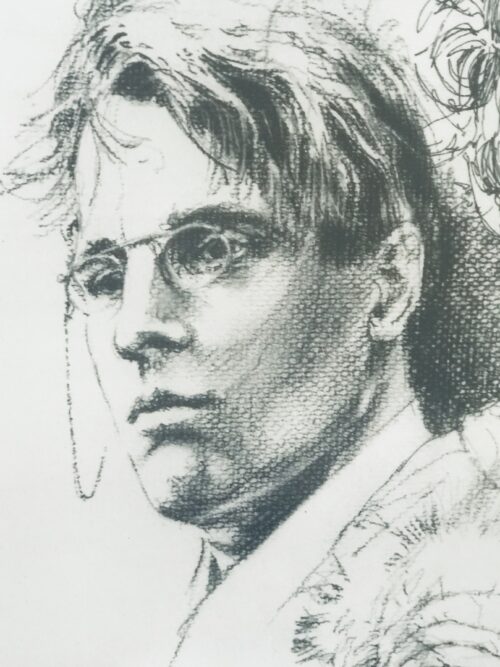
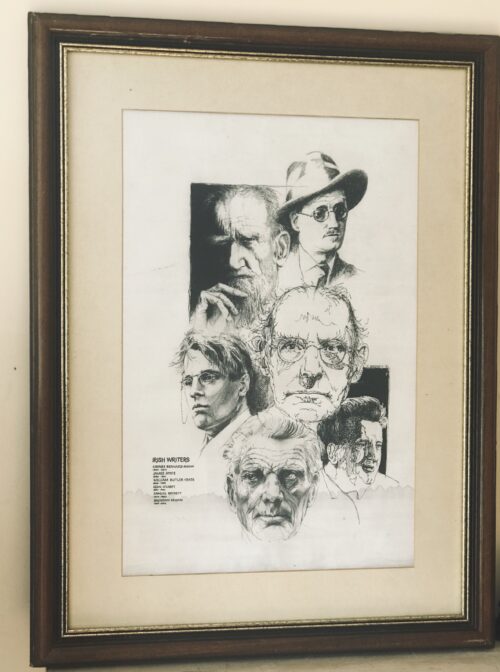 Striking and large print of a drawing on charcoal depicting five Irish Literary behemoths-James Joyce,W.B Yeats ,Samuel Beckett,Brendan Behan & Sean O'Casey.There is some slight water staining on the bottom of the front as this was stored in the basement of a long closed Dublin pub but now gladly resurrected and reframed. Dublin 90cm x 68cm
Striking and large print of a drawing on charcoal depicting five Irish Literary behemoths-James Joyce,W.B Yeats ,Samuel Beckett,Brendan Behan & Sean O'Casey.There is some slight water staining on the bottom of the front as this was stored in the basement of a long closed Dublin pub but now gladly resurrected and reframed. Dublin 90cm x 68cm -
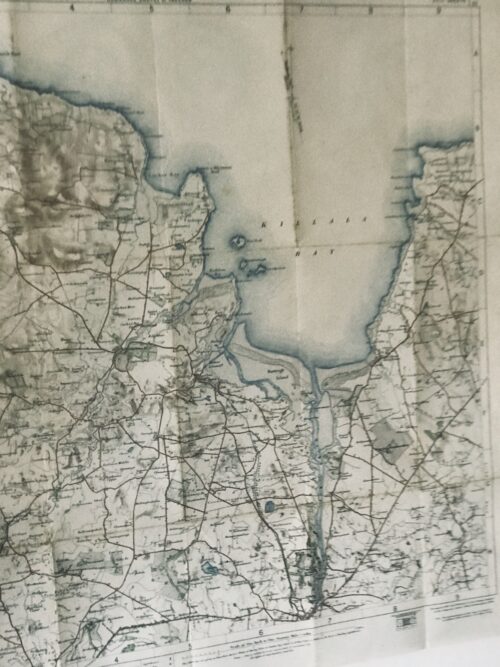
 Original ordnance survey map from 19 of Killala Bay Co Mayo in superb frame. Westport Co Mayo 65cm x 65cm Killala is a quiet seaside resort but the harbour warehouses show that it was once a busy port. This remote little town enjoys a place of disproportionate importance in the history of Ireland, as it was here that the French first halted when they invaded in 1798. The 1798 French invasion of Ireland On August 6, 1798, General Humbert’s “Army of Ireland” set sail from La Rochelle destined for Killala, Co. Mayo …
Original ordnance survey map from 19 of Killala Bay Co Mayo in superb frame. Westport Co Mayo 65cm x 65cm Killala is a quiet seaside resort but the harbour warehouses show that it was once a busy port. This remote little town enjoys a place of disproportionate importance in the history of Ireland, as it was here that the French first halted when they invaded in 1798. The 1798 French invasion of Ireland On August 6, 1798, General Humbert’s “Army of Ireland” set sail from La Rochelle destined for Killala, Co. Mayo …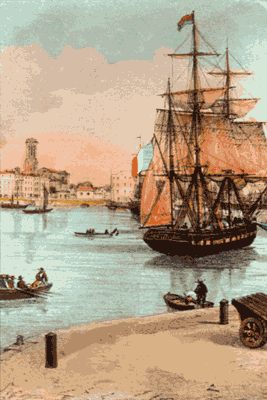
La Rochelle’s harbour.
On July 19, 1798, the French Directory authorises the sending of three expeditions to Ireland and gives command of the first one to General Humbert.
On August 6, 1798, General Humbert’s Army of Ireland sailed from La Rochelle in three frigates La Concorde, La Franchise, La Médée, carrying 1,025 French troops, 3 light field cannons, 3,000 muskets, and 400 sabres.
There were also a number of Irish among Humbert’s command. These included Bartholomew Teeling and Fr. Henry O Kane. This tiny force, together with its Irish allies, was to conduct an extraordinary campaign that shook the British Empire.During 16 days they sailed taking a circuitous route to avoid detection by the British navy. The mission of this little French expeditionary force was to provide military assistance to the Irish rebels of the “Rising of ’98” – sometimes referred to as “Bliadhan na bhFrancach” or “The Year of the French” – in their attempt to free Ireland from English domination.
The fleet had originally planned to land in Co. Donegal, but due to storm and no doubt influenced by the presence of Fr. O Kane who was a native of Killala the fleet sailed into Killala Bay.
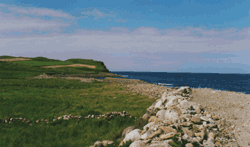
Kilcumminn head, Co. Mayo
On the 22nd of August, 1798, the three frigates landed at Kilcummin flying the English colours.
Edwin and Arthur Stock, sons of the Protestant Bishop of Killala, who had sailed out to meet them, greeted them. The two were captured, the English flag taken down and the French flag hoisted.
One of the first to disembark was Fr. O Kane who spoke to the locals in Irish which was the native tongue of most of the Irish at that time. Word soon filtered to native Irish throughout Mayo and Sligo.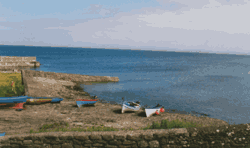
Kilcumminn strand,landing-place of the French
Bishop Stock also heard of the arrival and he sent messages to the local gentry among them the Jacksons, the Knoxs, Binghams, Palmers and Kirkwoods. Into the relative quiescence of northwest Ireland, the French expeditionary force fell like a thunderbolt. By about 7pm the landing was complete.
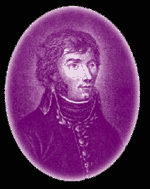
General Humbert
Young Général Jean-Joseph-Amable Humbert (the landing occurred on his 31st birthday), a canny veteran of irregular warfare against the insurgents of the Vendée, was well aware of the odds against him in a conventional military showdown, but also of the multiplying effects of surprise and speed.
He was also keenly aware of the importance of early victory for exciting the morale of the Irish insurgents and dismaying the ill-trained loyalist militia.
The first military confrontation occurred on the afternoon of 22 August, when Colonel Jean Sarrazin led a group of French Grenadiers south to the nearby village of Killala.

Killala, viewed from the north.
The garrison of 200 men included a handful of regulars of the 17th Foot (Leicestershire Regiment), but was mostly composed of the Yeomanry, an ill-trained part-time paramilitary constabulary.
With a portion of Sarrazin’s force circling around the British left flank and the remainder pressing a frontal attack with the bayonet, the unnerved Loyalists fired one ragged volley and then fled in terror towards Ballina.
Three Frenchmen were slightly wounded, bishop Stock’s palace was taken over as Humbert’s H.Q. and several of the yeomen were taken prisoner.

Ireland forever – l’Irlande pour toujours
A French soldier then climbed to the top of the palace and removed the British flag, which was replaced by a green and gold flag bearing the inscription ‘Erin Go Bragh’ (Ireland forever).
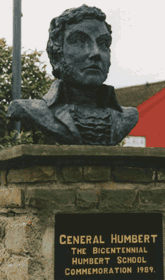
General Humbert statue in Killala.
LIBERTY, EQUALITY, FRATERNITY, UNION “After several unsuccessful attempts behold at last Frenchmen arrived amongst you . . . “Brave Irishmen, our cause is common. Like you we hold as indefeasible the right of all nations to liberty. Like you we are persuaded that the peace of the world shall ever be troubled as long as the British ministry is suffered to make with impunity a traffic of the industry and blood of the people . . . “Union, Liberty, the Irish Republic! Such is our shout. Let us march. Our hearts are devoted to you; our glory is in your happiness.”
From General Humbert’s Proclamation of 22nd August, 1798. (This last sentence of Humbert’s Proclamation became our pub’s motto!)
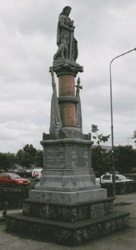
Mémorial de Ballina
This initial humbling of their oppressors had the desired effect on the local population, bringing forward thousands of eager, though ignorant and ill-disciplined Irish volunteers who were hastily equipped and formed into companies. Muskets were issued to some, but as in the uprisings elsewhere in Ireland that year, most of the insurgents were armed with crude pikes, scythes, and hay-forks.
On the 24th of August, having captured Killala, Humbert sent two groups under Sarrazin (provisionally promoted to Général de Brigade by Humbert on 23 August) and Adjudant-General Fontaine to capture Ballina.That night a fight took place between Sarrazin’s troops and the British at Rosserk. The English eventually retreated in confusion. The next morning the French/Irish troops captured Ballina under cover of darkness. The Irish peasants lit bundles of straw to show them their way. This approach road to Ballina has since been known as Bothair na Sop. They took Ballina without much resistance. The English for the most part fled towards Foxford where they would have their forces waiting for the French advance on Castlebar.
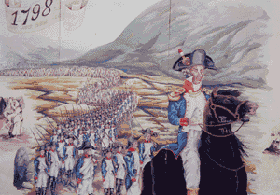
Humbert – Windy Gap Pass
The British commander in County Mayo, General Hutchinson, expected Humbert to continue south along the only decent road out of Ballina toward Castlebar, the commercial and strategic center of the region.
Where the road crosses the River Moy at Foxford, Hutchinson placed a strong blocking force with ample artillery. Clashes of French and British patrols along the Ballina-Foxford road appeared to confirm British expectations.Humbert, closely questioning the locals, learned that there was an alternative route to Castlebar, a barely-practicable goat-trail that ran west of Lough Conn, over the Windy Gap pass, and then south to the town. He resolved to take this route.
To further the deception, the Franco-Irish forces marched out of Ballina along the Foxford road at sunset on August 26 with ostentatious noise and shouted boasts of expected victory at Foxford, then doubled back in silence and darkness to the west of Loch Conn. At midnight, Humbert’s army was in Lahardane.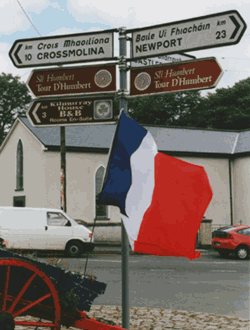
“Tour D’Humbert” signposts in Lahardane
The local priest, Father Andrew Conroy, was fluent in French from his time at seminary in Nantes.
He gave precious directions to the French officers and marshalled the people to provide food and assistance to the troops. In the aftermath of the campaign, Father Conroy was arrested, tried, and executed by the vengeful British.After a rigorous night-march of 40 km (25 miles), Humbert’s 800 French, 600 Irish, and 1 laboriously manhandled gun reached Castlebar on 27 August.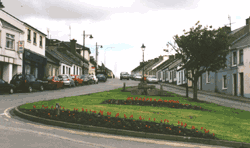
Sion Hill (now built-up)
A yeoman farmer who had been tending to his cattle had spotted the French/Irish advance party. He immediately fled to Castlebar to warn the British commander of the eminent arrival of the French/Irish forces.
The English forces took up position at Sion Hill just outside the town. Humbert approached and took account of the English position.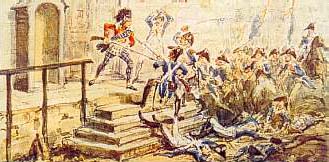
Batlle of Castlebar known as “Races of Castlebar”.
Following a number of attacks in which they were hit by British cannon, Humbert decided to regroup and divided his troops, splitting them to the left and right so as to attack the English flanks. The Irish drove a herd of cattle ahead of them causing confusion in the English rank. The French/Irish made an effective bayonet charge through the centre.
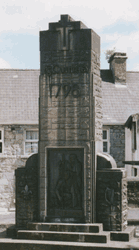
Castlebar Memorial
The English retreated down Staball Hill. Another attack occurred at Main St. Bridge. The English defended the bridge for some time using forces from the Longford and Kilkenny militias and Fraser Fencibles (a Scottish regiment).
There was confused fighting in the town as knots of the more stalwart British, notably the Fraser Fencibles and Roden’s Dragoons, attempted to make a stand.
The bulk of the redcoat forces, abandoning all guns, standards, and baggage, ran in headlong flight down the road to Tuam, 54 km (34 miles) to the southeast; some apparently did not stop until reaching Athlone, a further 68 km (42 miles) away. General Lake’s army being dissolved.
The event has since become mockingly known among the Irish as “The Castlebar Races.” In all the attack only lasted six hours from 6a.m. to 12 noon and has been described by Thomas Pakenham in The Year of Liberty as one of the most ignominious defeats in British military history. Following this brilliant victory, Humbert spent the next few days resting and reorganizing his army, absorbing many hundreds of new Irish volunteers including some 250 deserters from the Longford and Kilkenny Militias.The “Republic of Connaught” was proclaimed and a makeshift revolutionary government installed.Army of Ireland – Liberty, Equality
Head quarters at Castlebar, 14th Fructidor, sixth Year of the French Republic, One and Indivisible. General Humbert, Commander in Chief of the Army of Ireland, desirous of organizing with the least possible delay, an administrative power for the Province of Connaught, decrees as follows:
1. The Government of the Province of Connaught shall reside at Castlebar till further orders. 2. The Government shall be composed of twelve members, who shall be named by the General-in-chief of the French Army. 3. Citizen JOHN MOORE is named President of the Government of the Province of Connaught, he is specially entrusted with the nomination and reunion of the members of the Government. 4. The Government shall occupy itself immediately in organizing the Military power of the Province of Connaught, and with providing subsistence for the French and Irish Armies. 5. There shall be organized eight regiments of infantry, each of twelve hundred men, and four regiments of cavalry, each of six hundred men. 6. The Government shall declare rebels and traitors to the country all those who having received clothing and arms, shall not join the army within four and twenty hours. 7. Every individual from sixteen years of age to forty, inclusive, is REQUIRED in the name of the Irish Republic, to betake himself instantly to the French Camp, to march in a mass against the common enemy. The General Commanding-in-Chief HUMBERT.Lord Cornwallis (the same who had surrendered to Washington at Yorktown), now the Viceroy and Commander-in-Chief in Ireland, moved west from Dublin to take personal command of the campaign.It was obvious that after the fiasco of Castlebar, the Crown forces in Ireland would marshal every possible resource to crush Humbert.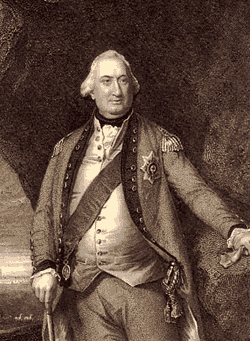
Lord Cornwallis
By the 2nd of September, Cornwallis had 7,800 men, including two reliable Scottish regiments (the Sutherland and Rehy Fencibles) concentrated at Tuam, organized into four brigades under Generals Hunter, Campbell, Hutchinson, and Moore (later the hero of Corunna), and a further 2,800 at Boyle.
Cornwallis advanced from Tuam on the 4th of September, but on arriving at Castlebar on the 5th found only a small Franco-Irish rearguard. Aware of the impossibility of defeating the well-equipped and far more numerous Crown forces, and with no sign of reinforcements from France, Humbert had marched off to the east on 4 September, under cover of darkness, taking his army, now totalling 3,000 men, towards Sligo, covering 58 miles in 36 hours. The long march had begun. Some Irish troops under French officers remained to protect Killala and receive the expected reinforcements.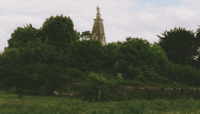
Collooney, Co. Sligo
On the morning of the 5th of September, an English army from Sligo under Col Vereker attacks the Franco-Irish army at Collooney with its left protected by the Ballysadare River and its right anchored on a steep, wooded hill. Humbert again outmanoeuvres them.
In what may be one of the greatest feats of individual bravery in the long history of the Revolutionary and Napoleonic Wars, Colonel Bartholomew Teeling, a United Irishman holding a French commission, galloped forward alone to the British line, pistolled the enemy gunner at point-blank range, and rode back unscathed under a hail of musket-fire. Inspired by his example, the Irish and French surged forward and routed the Loyalists. The English retreated with heavy losses as far as Ballyshannon, County Donegal.Cornwallis has now divided his army in two, one half under General Lake to pursue the enemy and the other half, under his own personal command, to protect the line of the river Shannon.
Ballinamuck pikeman
The French and Irish “must not cross”. Meanwhile, the United Irishmen of Longford and Westmeath have assembled. They capture Wilson’s Hospital near Mullingar but fail to take the town of Granard. Humbert, on hearing of the midlands rising decides to link up with the insurgents there.He is now near Manorhamilton but changes and goes straight for Granard. He abandons some of the heavier guns so as to make more speed. So far he has eluded the cordon closing in around him. With some luck he hopes to slip past the net, reach Granard and then strike for Dublin which is virtually unprotected as most of the garrison have been moved to Connacht. The Franco-Irish army reaches Drumkeerin in the evening of September 6. An envoy from Lord Cornwallis offers terms for surrender but they are rejected.On September 7, shortly before noon Humbert’s army crosses the Shannon at Ballintra Bridge just south of Loch Allen, but they fail in an attempt to demolish the bridge behind them.
His army shows signs of fatigue and skirmishes with the English advance guard become more frequent. The race for Granard quickens.
The Franco-Irish army reaches Cloone, in South Leitrim, while Cornwallis, with 15,000 men is at Mohill, five miles away. Humbert gets news that he is surrounded and outnumbered but decides to push on even if the best he can now do is to make a token resistance before surrender.On September 8, 1798, near the small village of Ballinamuck, County Longford, Humbert drew up his 859 French troops in line of battle. There could be little doubt of the outcome.
Behind Humbert was Cornwallis blocking Humbert’s way to Dublin. In front was Lake’s 6000 men. The battle which lasted but half an hour commenced with Colonel Crawford’s dragoons cutting through the Irish rebels. When the British grand assault poured up the hill from three sides, in overwhelming numbers, Humbert gave the order to surrender.
Humbert surrenders in Ballinamuck
The French officers followed their general’s signal and ordered their men to lay down their muskets. A second body of British cavalry had reined in seeing the signs of surrender, but Colonel Teeling, an Irish officer in the French army, had not signaled surrender so British infantry advanced on them. Crawford attacked a large contingent of Irishmen with his dragoons, their sabres sparing only those with officers insignia, hanging to be their fate.
Later testimonies reveal that on arresting Humbert, General Lake could not conceal his astonishment: “Where is your army?” Lake demanded “This is it all” Humbert replied, indicating his soldiers. “And what were you planning to do with this lot?” Lake asked. “We were going to Dublin to break the irons of a nation that suffers under your yoke” Humbert said. “That is an idea that could only be born in a Frenchman’s brains!” Lake declared.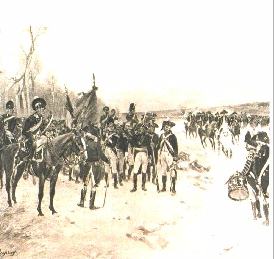
Humbert surrenders in Ballinamuck
Humbert and the French prisoners were conducted to Dublin and treated with all the consideration that could be given to gallant prisoners after an honorable defeat.
Not so the Irish. Accounts vary, but it appears that many of the Irish were cut down where they stood, or driven into the bog south of the hill where they were hunted down and slaughtered. Captured Irish officers, even those bearing legitimate commissions in the French army, were seized and hanged as traitors. Such was Bartholomew Teeling, Matthew Tone and Gunner James Magee’s fate.“After having obtained the greatest successes and made the arms of the French Republic triumph during my stay in Ireland, I have at length been obliged to submit to a superior force of 30,000 troops.” General Humbert’s Report to the French Directory after Ballinamuck.
‘A SHORT BUT VERY FATIGUING CAMPAIGN’
English historians have always treated General Humbert’s expedition to Ireland with ridicule, but Brian O hUiginn was fond of quoting Plowden the military correspondent of the London Times who held a different view. This expert wrote some years ago:
“In these operations described by Cornwallis to the Duke of Portland as a short but very fatiguing campaign, a raiding party of 1000 French landed in Ireland without opposition, after sixteen days of navigation, unobserved by the British Navy; defeated and drove back the British troops opposing them on four separate occasions; routed a force of second line troops of at least double its strength; captured eleven British guns; held the field for seventeen days; entirely occupied the attention of all the available troops of a garrison of Ireland 150,000 strong; penetrated almost to the centre of the island, and compelled the Lord Lieutenant to send an urgent requisition to London for ‘as great a reinforcement as possible.’ “
This was a fine tribute to General Humbert and his troops.- In Humbert’s footsteps 2013 – Killala & Castlebar
- In Humbert’s footsteps 2013 – Killala & Castlebar
- In Humbert’s footsteps 2013 – Killala & Castlebar
- In Humbert’s footsteps 2013 – Killala & Castlebar
The Charentais of the expedition.
Many Charentais took part in the expedition. Among them: Daniel Savary, who was born in Salles sur Mer (17), was in command of the naval division charged with transporting the expedition from La Rochelle to Killala. François Babin, born in Péré (17), became Commander of the Castlebar battalion. Jean Jobit, born in Chateauneuf en Charente (16), was a Commander on the Castlebar battlefield in Castlebar. Jean-Paul Leugerat, born in Barbezières (16), died during the battle of Castlebar. -

 Real retro GAA hurling photo here of Kevin Hennessy of Cork & Conor Hayes of Galway marking each other in an All Ireland Final.Conor is wearing what appears to be a very old Cooper Ice hockey Head guard and it became his signature piece during his career as Galway Captain and Full Back. Kiltormer Co Galway 29cm x 23cm Conor Hayes was a three-time All-Star. He made his debut for the Galway senior hurlers during the 1979 championship and went on to play a key role for the Tribesmen for over a decade, winning three All-Irelands and two National Leagues. He was captain when Galway won back-to-back All-Ireland titles in 1987 and 1988. Conor is also an All-Ireland winner at club level, having achieved the highest honour in club hurling with Kiltormer in 1992. He is the holder of two Connacht club championships and three Galway hurling championships with Kiltormer and was named on the Galway Hurling Team of the Millennium. Kevin Hennessy (born 8 March 1961) is an Irish retired hurler who played as a left-corner forward for the Cork senior team. Born in Midleton, County Cork, Hennessy first arrived on the inter-county scene at the age of 18 when he first linked up with the Cork minor team, before later lining out with the under-21 side. He made his senior debut in the 1982 championship. Hennessy went on to play a key part for over a decade, and won three All-Ireland medals and seven Munster medals. He was an All-Ireland runner-up on three occasions. Hennessy represented the Munster inter-provincial team in the early stages of his career, winning two Railway Cup medals. At club level he won one All-Ireland medal, two Munster medals and four championship medals with Midleton. Throughout his career Hennessy made 22 championship appearances for Cork. He retired from inter-county hurling following the conclusion of the 1993 championship.
Real retro GAA hurling photo here of Kevin Hennessy of Cork & Conor Hayes of Galway marking each other in an All Ireland Final.Conor is wearing what appears to be a very old Cooper Ice hockey Head guard and it became his signature piece during his career as Galway Captain and Full Back. Kiltormer Co Galway 29cm x 23cm Conor Hayes was a three-time All-Star. He made his debut for the Galway senior hurlers during the 1979 championship and went on to play a key role for the Tribesmen for over a decade, winning three All-Irelands and two National Leagues. He was captain when Galway won back-to-back All-Ireland titles in 1987 and 1988. Conor is also an All-Ireland winner at club level, having achieved the highest honour in club hurling with Kiltormer in 1992. He is the holder of two Connacht club championships and three Galway hurling championships with Kiltormer and was named on the Galway Hurling Team of the Millennium. Kevin Hennessy (born 8 March 1961) is an Irish retired hurler who played as a left-corner forward for the Cork senior team. Born in Midleton, County Cork, Hennessy first arrived on the inter-county scene at the age of 18 when he first linked up with the Cork minor team, before later lining out with the under-21 side. He made his senior debut in the 1982 championship. Hennessy went on to play a key part for over a decade, and won three All-Ireland medals and seven Munster medals. He was an All-Ireland runner-up on three occasions. Hennessy represented the Munster inter-provincial team in the early stages of his career, winning two Railway Cup medals. At club level he won one All-Ireland medal, two Munster medals and four championship medals with Midleton. Throughout his career Hennessy made 22 championship appearances for Cork. He retired from inter-county hurling following the conclusion of the 1993 championship. -

 Cork City 33cm x 38cm The Infamous Handshake between Roy Keane and Mick McCarthy that said it all
Cork City 33cm x 38cm The Infamous Handshake between Roy Keane and Mick McCarthy that said it all"Footballers are pragmatists. You play for the manager you have."
This is a quote from Roy Keane's autobiography [Page 76]. He was referring specifically to the Irish soccer players when Jack Charlton was the Republic of Ireland team manager, and to footballers in general. It would appear however that Keane had limits to his own pragmatism when it came to playing for Mick McCarthy as Irish manager.
The dynamics of the relationship between Roy Keane and Mick McCarthy are central to the whole Saipan incident. Clearly the two did not get on with each other. The question is - why? Keane and McCarthy are the only ones who can give a definitive answer to this but based upon the available evidence it appears to be primarily due to an intense dislike of McCarthy by Keane.
Roy Keane and Mick McCarthy Have a Row in Boston in 1992
Roy Keane and Mick McCarthy only played together for Ireland on two occasions, in September 1991 and May 1992. There are no generally known reports of any issues arising between the two men as players on the football pitch. However it was while Mick McCarthy was the Republic of Ireland team captain that the first instance of some discord between the two has been documented. During the fateful squad meeting, that led to the expulsion of Keane from the Irish World Cup squad, the Irish captain brought up an incident that had occurred a full ten years earlier. The now infamous Boston 1992 row.
It now seems that this otherwise innocuous event appears to have coloured the Keane and McCarthy relationship
from that time onward. A drunken 20 year old Keane had turned up late for the team bus at the end of a soccer tournament in the US. When the team captain Mick McCarthy challenged Keane about being late a heated row ensued. Roy Keane seems to have taken extreme exception to this. It is difficult to believe that such an event would even register the next day with Keane who seems to have spent his entire life going from one scrape to another. Keane admits in his autobiography that he has had hundreds or thousands of rows throughout his soccer career. Why should this one have been so significant to him?One possible explanation is that when Keane is drunk his, already low, tolerance levels become even lower. Any perceived slight is magnified disproportionately. Keane's autobiography is littered with stories about him getting into angry and violent situations when he was drunk. By his own admission there were many situations when he knew he should have walked away but his own sense of offence prevented him doing just that. These events seem to have made an indelible mark on his brain as they are recounted with real clarity in his book. It seems that a run of the mill, for footballers, exchange between McCarthy and Keane in 1992, magnified in intensity by his drunken state, soured Keane's view of McCarthy from that point on.
"Let Bygones be Bygones" - Roy Keane
There do not appear to have been any further meaningful interactions between the two until McCarthy was appointed as manager of the Republic of Ireland football team in 1996. In his autobiography [Page 246] Keane reveals an antipathy towards McCarthy that seems, to some extent, to be born out of Roy Keane's relationship with Jack Charlton. In his book Keane makes it clear that he had no time for Charlton "...I found it impossible to relate to him as a man or as a coach." [Page 54]. When commenting on McCarthy's appointment as Irish manager he said "McCarthy was part of the Charlton legend. Captain Fantastic...he didn't convince me. Still, when he got the job, I thought: let bygones be bygones." What bygones? Presumably the exchange between the pair in Boston six years earlier?
In his World Cup Diary McCarthy makes a case that he had gone to some lengths as manager of Ireland to accommodate Keane and his sensitivities. He had made Keane the captain of Ireland at the first opportunity. He allowed Keane to turn up later than the other players for international matches. Keane was the only player in the Irish squad that roomed alone. He also says that he put up "...with the odd tantrum from Keane here and there...". McCarthy contends that if he was holding a grudge towards Keane from 1992 he would not have gone to these lengths.
Roy Keane's first match for Ireland with Mick McCarthy as manager was an inauspicious occasion for the Manchester United player. Earning his 30th cap and wearing the captain's armband in place of the substituted Andy Townsend, Keane was sent off late in the match for kicking a Russian player.
Lack of Direct Communication Between Roy Keane & Mick McCarthy
The next notable point of conflict between Keane and McCarthy was on the occasion of a Republic of Ireland trip to the USA for an end of season international tournament in 1996. Keane decided that he didn't want to go as he was too tired after the season just ended. [Page 246]. Rather than contact McCarthy or anyone else in the Irish set up, Keane left it to someone at Old Trafford to inform the FAI. "As a result I got off to a bad start with McCarthy. He felt I should have spoken to him personally. He expressed this opinion, casting me in a bad light. What he didn't tell the media that if we had that sort of conversation on this occasion, it would have been our first." [Page 247]. This begs the question, why couldn't Keane contact McCarthy directly? Why would this have been the first such discussion between the two men as manager and team captain? It certainly doesn't suggest that Keane had, in reality, let bygones be bygones.
In his World Cup Diary McCarthy refers to the the 1996 USA trip. "I was never that bothered if he (Keane) went to America or not...it became a big media story...We have had a few chats to sort things out but it has all dragged on since then in the press." [Page 33].
In his autobiography Keane complains bitterly about the poor Republic of Ireland set up especially when compared to that of Manchester United. After the draw for the 2002 World Cup qualifiers was made Keane says that he met with McCarthy"...to level with him, to make the case for a reformed approach...We discussed the problems. He agreed with me...It was not and easy conversation - we're not not buddy-buddy...I thought we had a deal."[Page 250]. Interestingly this meeting took place at Keane's house in Manchester.
What is clear is that there was an unusual relationship between the Irish manager and his captain. Direct communication between McCarthy and Keane was kept to an absolute minimum. All of the available evidence is that was the way Keane wanted it. Keane admitted this in his interview with Tom Humphries in Saipan "I spoke to Mick Byrne, who's the middle man for me, really." For a man who has very admirable communication skills this is somewhat strange. Why would he need a middle man? The only possible explanation is that Roy Keane did not like Mick McCarthy and couldn't bear to be anywhere near him or have anything to do with him. During McCarthy's tenure as Irish manager Roy Keane took every opportunity to minimise his time with the Irish squad. "I dreaded the prospect of international weeks."[Page 250].
Conclusion
With the benefit of hindsight and with the insights afforded by Keane's autobiography it is clear that there was no way possible that Roy Keane could maintain an even keel while being away with Ireland for the duration of the World Cup campaign. All of his complaints about the crowded airport, the missing training gear, the poor training facilities, the goalkeeper row, were just symptoms. Clearly McCarthy and the FAI could have done better but the inescapable conclusion to be drawn is that even if conditions and facilities had been perfect Keane simply could not endure being in such close proximity to Mick McCarthy for such a protracted period of time. A Saipan incidentwas inevitable even before Roy Keane set foot on the plane to that Pacific island.
NOTE: Unless stated otherwise all quotations are from: Keane: The Autobiography; Roy Keane with Eamon Dunphy (2002); Michael Joseph Ltd
-

 Team photo from before the 1977 All Ireland SemiFinal of that great Dublin side. Dublin 22cm x 27cm here have been many memorable battles between Dublin and Kerry down through the years, but the meeting between the two sides on the 21st of August 1977 has been described many times as the greatest game of all time. The country was gripped by this fierce rivalry that built up through the 70’s. This was the third year in a row that the two sides went toe to toe with both teams up claiming a win each. The game started at a furious pace that didn’t wane for the entire match. Dublin missed a couple of early goal chances and it was Kerry’s Seán Walsh hit the first three pointer to leave a goal between the sides at the break. Dublin though dominated the midfield sector particularly with the second half introduction Bernard Brogan. With the Dubs in the ascendancy early in the second period they took full advantage and a John McCarthy goal leveled the game brought them right back into it. The action flowed from one end of the Croke Park pitch to the other with the sides exchanging a flurry of points. The intensity levels rose dramatically both on the pitch and in the stands as this thriller continued to enthrall and excite throughout. But two late goals clinched it for Kevin Heffernan’s men, Tony Hanahoe gathered a loose ball around the middle, passed it off to David Hickey who strode forward and hit a brilliant shot to the back of the net for Dublin’s second goal. Just before the final whistle the Sky Blues grabbed their third goal, a sweeping move involving David Hickey, Tony Hanahoe and Bobby Doyle seen the ball end up in the hands of Bernard Brogan who unleashed a rocket which almost took the net off the goal and Dublin claimed a well deserved victory.
Team photo from before the 1977 All Ireland SemiFinal of that great Dublin side. Dublin 22cm x 27cm here have been many memorable battles between Dublin and Kerry down through the years, but the meeting between the two sides on the 21st of August 1977 has been described many times as the greatest game of all time. The country was gripped by this fierce rivalry that built up through the 70’s. This was the third year in a row that the two sides went toe to toe with both teams up claiming a win each. The game started at a furious pace that didn’t wane for the entire match. Dublin missed a couple of early goal chances and it was Kerry’s Seán Walsh hit the first three pointer to leave a goal between the sides at the break. Dublin though dominated the midfield sector particularly with the second half introduction Bernard Brogan. With the Dubs in the ascendancy early in the second period they took full advantage and a John McCarthy goal leveled the game brought them right back into it. The action flowed from one end of the Croke Park pitch to the other with the sides exchanging a flurry of points. The intensity levels rose dramatically both on the pitch and in the stands as this thriller continued to enthrall and excite throughout. But two late goals clinched it for Kevin Heffernan’s men, Tony Hanahoe gathered a loose ball around the middle, passed it off to David Hickey who strode forward and hit a brilliant shot to the back of the net for Dublin’s second goal. Just before the final whistle the Sky Blues grabbed their third goal, a sweeping move involving David Hickey, Tony Hanahoe and Bobby Doyle seen the ball end up in the hands of Bernard Brogan who unleashed a rocket which almost took the net off the goal and Dublin claimed a well deserved victory.

